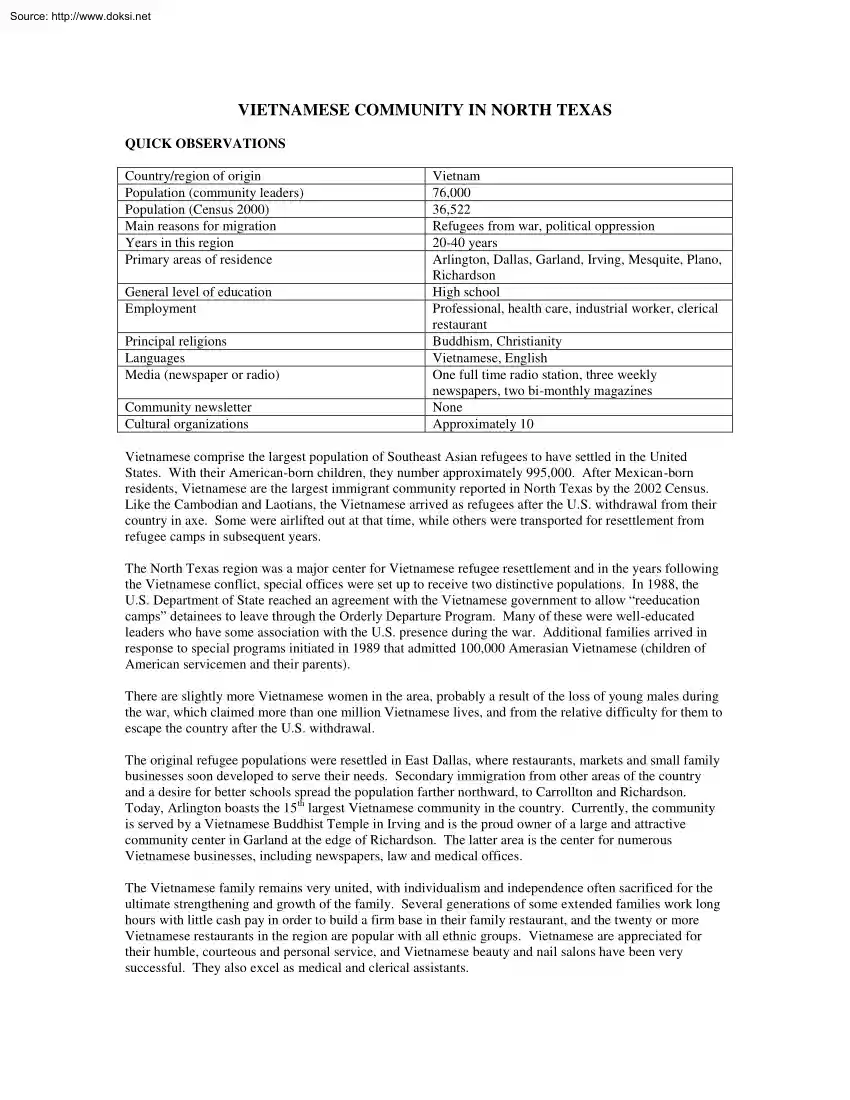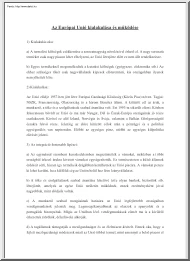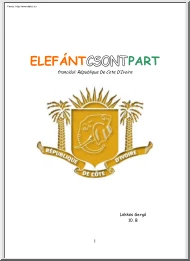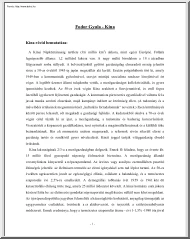Datasheet
Year, pagecount:2010, 2 page(s)
Language:English
Downloads:2
Uploaded:September 17, 2018
Size:500 KB
Institution:
-
Comments:
Attachment:-
Download in PDF:Please log in!
Comments
No comments yet. You can be the first!Most popular documents in this category
Content extract
Source: http://www.doksinet VIETNAMESE COMMUNITY IN NORTH TEXAS QUICK OBSERVATIONS Country/region of origin Population (community leaders) Population (Census 2000) Main reasons for migration Years in this region Primary areas of residence General level of education Employment Principal religions Languages Media (newspaper or radio) Community newsletter Cultural organizations Vietnam 76,000 36,522 Refugees from war, political oppression 20-40 years Arlington, Dallas, Garland, Irving, Mesquite, Plano, Richardson High school Professional, health care, industrial worker, clerical restaurant Buddhism, Christianity Vietnamese, English One full time radio station, three weekly newspapers, two bi-monthly magazines None Approximately 10 Vietnamese comprise the largest population of Southeast Asian refugees to have settled in the United States. With their American-born children, they number approximately 995,000 After Mexican-born residents, Vietnamese are the largest immigrant community
reported in North Texas by the 2002 Census. Like the Cambodian and Laotians, the Vietnamese arrived as refugees after the U.S withdrawal from their country in axe. Some were airlifted out at that time, while others were transported for resettlement from refugee camps in subsequent years. The North Texas region was a major center for Vietnamese refugee resettlement and in the years following the Vietnamese conflict, special offices were set up to receive two distinctive populations. In 1988, the U.S Department of State reached an agreement with the Vietnamese government to allow “reeducation camps” detainees to leave through the Orderly Departure Program. Many of these were well-educated leaders who have some association with the U.S presence during the war Additional families arrived in response to special programs initiated in 1989 that admitted 100,000 Amerasian Vietnamese (children of American servicemen and their parents). There are slightly more Vietnamese women in the area,
probably a result of the loss of young males during the war, which claimed more than one million Vietnamese lives, and from the relative difficulty for them to escape the country after the U.S withdrawal The original refugee populations were resettled in East Dallas, where restaurants, markets and small family businesses soon developed to serve their needs. Secondary immigration from other areas of the country and a desire for better schools spread the population farther northward, to Carrollton and Richardson. Today, Arlington boasts the 15th largest Vietnamese community in the country. Currently, the community is served by a Vietnamese Buddhist Temple in Irving and is the proud owner of a large and attractive community center in Garland at the edge of Richardson. The latter area is the center for numerous Vietnamese businesses, including newspapers, law and medical offices. The Vietnamese family remains very united, with individualism and independence often sacrificed for the
ultimate strengthening and growth of the family. Several generations of some extended families work long hours with little cash pay in order to build a firm base in their family restaurant, and the twenty or more Vietnamese restaurants in the region are popular with all ethnic groups. Vietnamese are appreciated for their humble, courteous and personal service, and Vietnamese beauty and nail salons have been very successful. They also excel as medical and clerical assistants Source: http://www.doksinet As women, headed many of the original families with little education, acculturation was challenging for some of these families, some have been unable to progress economically. One resulting problem is the development of Vietnamese gangs, which appeal to young boys who have no strong male role models and who feel adrift in-between two cultures. Middle-aged Vietnamese are beginning to visit their country, as relations soften between Vietnam and the United States. Many others continue to
send money back to help their extended families that are unable or unwilling to leave for the West. OTHER SOCIAL CHARACTERISTICS Age Distribution Percentage of men and women Ties to country of origin Frequency of travel to country of origin Estimate of undocumented Evenly distributed 60% women, 40% men Send money back regularly, phone relatives and members of nuclear family weekly Some travel often and some do not Less than 5% Material Source: DFW International aweiss@airmail.net OUTREACH STRATEGIES If a Vietnamese church is close, work with them on strategies: Youth/Children’s ministries Build relationships Share your faith Offer needed ministries such as ESL, etc. Include Vietnamese with the youth at your church Celebrate the New Year More Bible studies HOW DO YOU OPEN THE DOOR TO CONVERSATIONS ABOUT FAITH? Share your everyday relationship with Godanswered prayers, Scriptures that comfort Ask about how needs are met through their faithloneliness, courage, direction Offer to pray
for their needs Give books/videos that tell a faith story Discover their interests and find Christians in that field to share their story Look for Bible stories or principles that teach a value they respect
reported in North Texas by the 2002 Census. Like the Cambodian and Laotians, the Vietnamese arrived as refugees after the U.S withdrawal from their country in axe. Some were airlifted out at that time, while others were transported for resettlement from refugee camps in subsequent years. The North Texas region was a major center for Vietnamese refugee resettlement and in the years following the Vietnamese conflict, special offices were set up to receive two distinctive populations. In 1988, the U.S Department of State reached an agreement with the Vietnamese government to allow “reeducation camps” detainees to leave through the Orderly Departure Program. Many of these were well-educated leaders who have some association with the U.S presence during the war Additional families arrived in response to special programs initiated in 1989 that admitted 100,000 Amerasian Vietnamese (children of American servicemen and their parents). There are slightly more Vietnamese women in the area,
probably a result of the loss of young males during the war, which claimed more than one million Vietnamese lives, and from the relative difficulty for them to escape the country after the U.S withdrawal The original refugee populations were resettled in East Dallas, where restaurants, markets and small family businesses soon developed to serve their needs. Secondary immigration from other areas of the country and a desire for better schools spread the population farther northward, to Carrollton and Richardson. Today, Arlington boasts the 15th largest Vietnamese community in the country. Currently, the community is served by a Vietnamese Buddhist Temple in Irving and is the proud owner of a large and attractive community center in Garland at the edge of Richardson. The latter area is the center for numerous Vietnamese businesses, including newspapers, law and medical offices. The Vietnamese family remains very united, with individualism and independence often sacrificed for the
ultimate strengthening and growth of the family. Several generations of some extended families work long hours with little cash pay in order to build a firm base in their family restaurant, and the twenty or more Vietnamese restaurants in the region are popular with all ethnic groups. Vietnamese are appreciated for their humble, courteous and personal service, and Vietnamese beauty and nail salons have been very successful. They also excel as medical and clerical assistants Source: http://www.doksinet As women, headed many of the original families with little education, acculturation was challenging for some of these families, some have been unable to progress economically. One resulting problem is the development of Vietnamese gangs, which appeal to young boys who have no strong male role models and who feel adrift in-between two cultures. Middle-aged Vietnamese are beginning to visit their country, as relations soften between Vietnam and the United States. Many others continue to
send money back to help their extended families that are unable or unwilling to leave for the West. OTHER SOCIAL CHARACTERISTICS Age Distribution Percentage of men and women Ties to country of origin Frequency of travel to country of origin Estimate of undocumented Evenly distributed 60% women, 40% men Send money back regularly, phone relatives and members of nuclear family weekly Some travel often and some do not Less than 5% Material Source: DFW International aweiss@airmail.net OUTREACH STRATEGIES If a Vietnamese church is close, work with them on strategies: Youth/Children’s ministries Build relationships Share your faith Offer needed ministries such as ESL, etc. Include Vietnamese with the youth at your church Celebrate the New Year More Bible studies HOW DO YOU OPEN THE DOOR TO CONVERSATIONS ABOUT FAITH? Share your everyday relationship with Godanswered prayers, Scriptures that comfort Ask about how needs are met through their faithloneliness, courage, direction Offer to pray
for their needs Give books/videos that tell a faith story Discover their interests and find Christians in that field to share their story Look for Bible stories or principles that teach a value they respect





 Just like you draw up a plan when you’re going to war, building a house, or even going on vacation, you need to draw up a plan for your business. This tutorial will help you to clearly see where you are and make it possible to understand where you’re going.
Just like you draw up a plan when you’re going to war, building a house, or even going on vacation, you need to draw up a plan for your business. This tutorial will help you to clearly see where you are and make it possible to understand where you’re going.